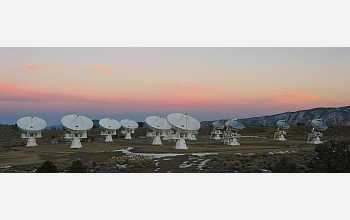News Release 06-078
Astronomers Dedicate CARMA Telescope Array

CARMA will produce millimeter-wave images almost as sharp as Hubble's optical images.
May 5, 2006
This material is available primarily for archival purposes. Telephone numbers or other contact information may be out of date; please see current contact information at media contacts.
On Friday, May 5, astronomers will dedicate a millimeter-wave telescope array that will serve as the most powerful instrument of its type for years to come.
The Combined Array for Research in Millimeter-Wave Astronomy (CARMA), a joint venture of the California Institute of Technology, the University of California at Berkeley, the University of Maryland and the University of Illinois, was created by moving the six 10-meter telescopes at Caltech's Owens Valley Radio Observatory, along with nine 6-meter telescopes at the Berkeley-Illinois-Maryland Association array, to a new location at Cedar Flat in the Inyo Mountains near Bishop, Calif.
The National Science Foundation (NSF) has supported both the earlier arrays since their inception, and will continue to support CARMA operations.
CARMA's new location in the dry desert air of Cedar Flat, whose 7,200-foot elevation is more than twice that of either previous site, will give the combined 15-telescope array unparalleled sensitivity. Indeed, the array will produce millimeter-wave images comparable in resolution to the Hubble Space Telescope's optical images.
"CARMA will do great science in a lot of different areas," says Richard Barvainis, the NSF program officer in charge of the project. Its targets will include cold molecular gas that fuels star formation and feeds massive black holes; disks of gas and dust that may one day give rise to planets around newly forming stars; interstellar clouds that can form the molecular building blocks of life; and fluctuations in the cosmic microwave background radiation that provide clues to the origin and early evolution of the universe.
Perhaps just as important, adds Barvainis, "CARMA will serve as the pathfinder for ALMA"--the Atacama Large Millimeter Array that is now being built in the Chilean Andes with funding from NSF, Canada, Japan, Europe and Chile. When ALMA is completed in 2012, it will have a resolution ten times better than Hubble's.
For more information about CARMA, visit http://www.mmarray.org/.
For more information about ALMA, visit http://www.alma.nrao.edu/.
-NSF-
Media Contacts
M. Mitchell Waldrop, NSF, (703) 292-7752, email: mwaldrop@nsf.gov
Related Websites
The CARMA Web site: http://www.mmarray.org
The ALMA Web site: http://www.alma.nrao.edu/
The U.S. National Science Foundation propels the nation forward by advancing fundamental research in all fields of science and engineering. NSF supports research and people by providing facilities, instruments and funding to support their ingenuity and sustain the U.S. as a global leader in research and innovation. With a fiscal year 2023 budget of $9.5 billion, NSF funds reach all 50 states through grants to nearly 2,000 colleges, universities and institutions. Each year, NSF receives more than 40,000 competitive proposals and makes about 11,000 new awards. Those awards include support for cooperative research with industry, Arctic and Antarctic research and operations, and U.S. participation in international scientific efforts.
Connect with us online
NSF website: nsf.gov
NSF News: nsf.gov/news
For News Media: nsf.gov/news/newsroom
Statistics: nsf.gov/statistics/
Awards database: nsf.gov/awardsearch/
Follow us on social
Twitter: twitter.com/NSF
Facebook: facebook.com/US.NSF
Instagram: instagram.com/nsfgov


